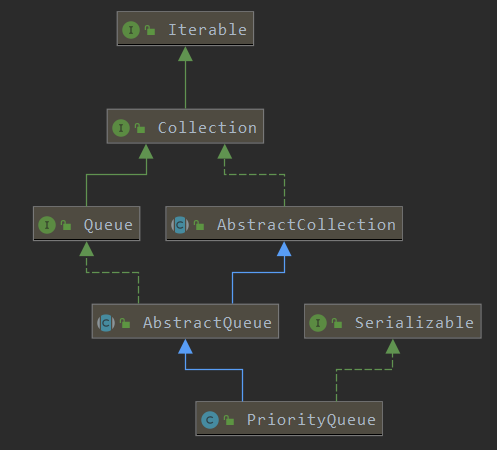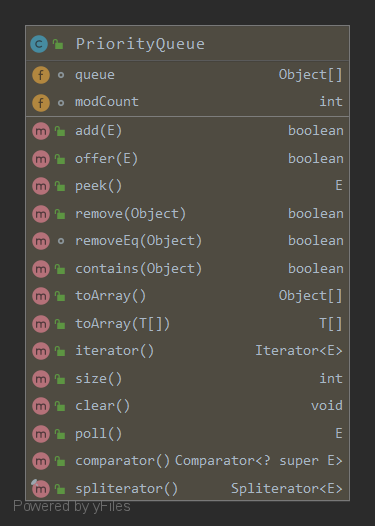研究了二叉堆实现原理,现在来看看JDK里面基于二叉堆的优先队列怎么实现的!
关键点:基于priority heap,无界队列,实现Queue,Collection,Iterator接口、不允许null键/值、非线程安全、enqueue和dequeue都是O(long(n)),remove和contains是O(n),peek是O(1);
从PriorityQueue的
概念,结构,参数,源码解析(offer,poll,remove,add,grow),性能,线程安全性,使用场景,常见问题8个方面进行分析。
概念
- 优先队列跟普通的队列不一样,普通队列遵循FIFO规则出队入队,而优先队列每次都是优先级最高出队。
- 优先队列内部维护着一个堆,每次取数据的时候都从堆顶取,这是优先队列的基本工作原理。
jdk的优先队列使用PriorityQueue这个类,使用者可以自己定义优先级规则。
An
unbounded priority queuebased on apriority heap.- The elements of the priority queue are ordered according to their
natural ordering, or by aComparator providedat queue >construction time, depending on which constructor is used.- A priority queue does
not permit null elements.- A priority queue relying on natural ordering also does
not permit insertion of non-comparable objects(doing so may result in >ClassCastException).- The
head of this queueis theleast elementwith respect to thespecified ordering. If multiple elements are tied for >least value, the head is one of those elements — ties are broken arbitrarily.- The queue retrieval operations
poll,remove,peek, and element access the element at the head of the queue.A priority queue is unbounded, but has aninternal capacitygoverning the size of anarrayused to store the elements on >the queue. It is always at least as large as the queue size. As elements are added to a priority queue, itscapacity grows >automatically. The details of the growth policy are not specified.- This class and its iterator implement all of the optional methods of the
Collection and Iterator interfaces.- The Iterator provided in method iterator() is
not guaranteedto traverse the elements of the priority queue in any particular >order. If you need ordered traversal, consider usingArrays.sort(pq.toArray()).- Note that this implementation is
not synchronized. Multiple threads should not access a PriorityQueue instance concurrently if >any of the threads modifies the queue. Instead, use thethread-safe PriorityBlockingQueueclass.- Implementation note: this implementation provides
O(log(n)) timefor theenqueuinganddequeuingmethods (offer, poll, remove() and add);linear timefor theremove(Object) and contains(Object)methods;constant timefor the retrieval methods (peek, element, and size).
This class is a member of theJava Collections Framework.PriorityQueue的类关系

PriorityQueue的类成员

结构
一维数组
- Priority queue represented as a
balanced binary heap: - the two children of queue[n] are queue[2n+1] and queue[2(n+1)].
- The priority queue is
ordered by comparator, or by the elements’natural ordering, - if comparator is null: For each node n in the heap and each descendant d of n, n <= d.
- The element with the
lowest valueis in queue[0], assuming the queue is nonempty.1
2// non-private to simplify nested class access
transient Object[] queue;
参数
initialCapacity:初始化容量,默认为11;comparator:用于队列中元素排序;size:记录队列中元素个数;modCount:记录队列修改次数;- 构造函数:新建1个空的队列;
1
2
3
4public PriorityQueue(int initialCapacity, Comparator<? super E> comparator) {
this.queue = new Object[initialCapacity];
this.comparator = comparator;
} - 如果是由
SortedSet,PriorityQueue这种有序的结构构建优先队列,直接Arrays.copyOf把数据复制到queue数组中; - 如果是由无序数组构建优先队列,需要把数据复制到queue数组中后,执行
构建堆(heapify)操作;
源码解析
heapify-构建堆
1 | /** |
siftDown-下沉
1 |
|
按字典顺序swap下沉
2
3
4
5
6
7
8
9
10
11
12
13
14
15
16
17
18
19
20
21
22
23
24
25
26
27
28
29
private void siftDownComparable(int parent, E x) {
Comparable<? super E> parentVal = (Comparable<? super E>) x;
int half = size >>> 1;
//二叉树结构,下标大于size/2都是叶子节点,其他的节点都有子节点。
//循环直到k没有子节点:loop while a non-leaf
while (parent < half) {
//假设left节点为child中的最小值节点
int left = (parent << 1) + 1;
int right = left + 1;
Object minVal = queue[left];
//存在right,且right<left,则最小为right
if (right < size && ((Comparable<? super E>) minVal).compareTo((E) queue[right]) > 0) {
left = right;
minVal = queue[right];
}
//如果parent节点<min(left,right),则不需要swap
if (parentVal.compareTo((E) minVal) <= 0) {
break;
}
//否则swap parent节点和min(left,right)的节点
queue[parent] = minVal;
//当前父节点取最小值的index继续loop
parent = left;
}
//1.当前节点没有子节点,则k是叶子节点的下标,没有比它更小的了,直接赋值即可
//2.当前节点下沉n轮后,将节点的值放到最终不需要再交换的位置(没有比它更小的或者到达叶子节点)
queue[parent] = parentVal;
}按自定义顺序swap下沉,与siftDownComparable类似
2
3
4
5
6
7
8
9
10
11
12
13
14
15
16
17
private void siftDownUsingComparator(int k, E x) {
int half = size >>> 1;
while (k < half) {
int child = (k << 1) + 1;
Object c = queue[child];
int right = child + 1;
if (right < size &&
comparator.compare((E) c, (E) queue[right]) > 0)
c = queue[child = right];
if (comparator.compare(x, (E) c) <= 0)
break;
queue[k] = c;
k = child;
}
queue[k] = x;
}
offer
1 | /** |
1 | /** |
队列已满时,动态扩容:小于64时2倍扩容,大于64时0.5倍扩容;
2
3
4
5
6
7
8
9
10
11
12
13
14
15
16
17
18
19
20
21
22
23
24
25
26
27
* Increases the capacity of the array.
*
* @param minCapacity the desired minimum capacity
*/
private void grow(int minCapacity) {
int oldCapacity = queue.length;
// Double size if size<64; else grow by 50%
int newCapacity = oldCapacity + (
(oldCapacity < 64) ? (oldCapacity + 2) :(oldCapacity >> 1)
);
// overflow-conscious code 防越界
if (newCapacity - MAX_ARRAY_SIZE > 0)
newCapacity = hugeCapacity(minCapacity);
//将queue中数据复制到扩容后的queue
queue = Arrays.copyOf(queue, newCapacity);
}
private static int hugeCapacity(int minCapacity) {
// overflow
if (minCapacity < 0) {
throw new OutOfMemoryError();
}
return (minCapacity > MAX_ARRAY_SIZE) ?
Integer.MAX_VALUE :
MAX_ARRAY_SIZE;
}节点上浮调整
2
3
4
5
6
7
8
9
10
11
12
13
14
15
/**
* Inserts item x at position k,
* maintaining heap invariant by promoting x up the tree until it is greater than or equal to its parent, or is the root.
* 为保持堆的性质,将插入元素x一路上浮,直到满足x节点值>=父节点值,或者到达根节点;
* @param k the position to fill 插入位置
* @param x the item to insert 插入元素
*/
private void siftUp(int k, E x) {
if (comparator != null) {
siftUpUsingComparator(k, x);
} else {
siftUpComparable(k, x);
}
}按字典顺序swap上浮
2
3
4
5
6
7
8
9
10
11
12
13
14
15
16
17
18
19
20
21
private void siftUpComparable(int k, E x) {
Comparable<? super E> key = (Comparable<? super E>) x;
//从当前节点循环上浮到堆顶节点
while (k > 0) {
//k节点的父节点索引
int parent = (k - 1) >>> 1;
//k节点的父节点值
Object e = queue[parent];
//比较k节点与父节点的值大小,父节点值较小时,终止遍历
if (key.compareTo((E) e) >= 0) {
break;
}
//父节点值较大时,交换k节点与父节点值
queue[k] = e;
//当前节点移到父节点,继续向上遍历
k = parent;
}
//将当前节点值赋给交换后的父节点
queue[k] = key;
}
按自定义顺序swap上浮,与siftUpComparable类似
2
3
4
5
6
7
8
9
10
11
12
private void siftUpUsingComparator(int k, E x) {
while (k > 0) {
int parent = (k - 1) >>> 1;
Object e = queue[parent];
if (comparator.compare(x, (E) e) >= 0)
break;
queue[k] = e;
k = parent;
}
queue[k] = x;
}add
2
3
return offer(e);
}remove
2
3
4
5
6
7
8
9
10
11
12
13
14
15
16
17
18
19
20
21
22
23
24
25
26
27
28
29
30
31
32
33
34
35
36
37
38
39
/**
* Removes the ith element from queue.
* <p>
* Normally this method leaves the elements at up to i-1,
* inclusive, untouched. Under these circumstances, it returns null.
* Occasionally, in order to maintain the heap invariant,
* it must swap a later element of the list with one earlier thani.
* Under these circumstances,
* this method returns the element that was previously at the end of the list and is now at some position before i.
* This fact is used by iterator.remove so as to avoid missing traversing elements.
*/
("unchecked")
private E removeAt(int i) {
assert i >= 0 && i < size;
// 修改次数+1
modCount++;
// 堆尾元素Index
int s = --size;
if (s == i) {
//如果删除的是堆尾元素,不需要进行siftUp
queue[i] = null;
} else {
//拿出堆尾元素
E moved = (E) queue[s];
queue[s] = null;
//将堆尾元素放到要删除的元素的位置,并执行siftDown
siftDown(i, moved);
//siftDown后,若元素没有改变,可能是因为要删除的结点和堆尾结点是跨子树,或者要删除的结点是叶子结点
if (queue[i] == moved) {
//如果删除的元素和堆尾元素不在一个子树,需要siftUp操作
siftUp(i, moved);
if (queue[i] != moved) {
return moved;
}
}
}
return null;
}注意
- 普通元素删除,将堆尾元素和要删除的位置替换,然后
siftDown就可以;- 但当删除的元素和堆尾元素之间如果是
跨子树的话,需要从删除位置执行siftUp操作;
示例删除5,siftdown后
2
3
4 1
5 6 2 3此时还需要siftup一次,才能满足二叉堆的结构
2
3
4 1
3 6 2
2
3
3 1
4 6 2
poll
1 | public E poll() { |
peek
1 | public E peek() { |
性能
参考二叉堆性能
O(log(n)) timefor theenqueuinganddequeuingmethods (offer, poll, remove() and add);linear timefor theremove(Object) and contains(Object)methods;constant timefor the retrieval methods (peek, element, and size).线程安全性
并发修改队列时非线程安全,线程安全版本使用PriorityBlockingQueue使用场景
PriorityQueue处理优先级场景
如医院急诊科接诊要按病痛的优先级处理;构建好优先队列后逐个poll即可;
PriorityQueue求TopK大/小的元素
使用小顶堆来实现TopK问题求解:维护一个大小为K的最大堆,那么在堆中的数都是TopK。
- 处理过程:在添加一个元素之后,如果小顶堆的大小大于 K,那么需要将小顶堆的堆顶元素去除
- 时间复杂度:O(Nlog(K))
- 空间复杂度: O(K)
- 特别适合处理
海量数据
在海量数据场景下,单机通常不能存放下所有数据。
- 拆分:可以按照
哈希取模方式拆分到多台机器上;在每个机器上维护最大堆; - 整合:将每台机器得到的最大堆
合并成最终的最大堆。
1 |
|
注意:可以skip比堆顶还小的元素
求 Top k,更简单的方法可以直接用内置的
TreeMap或者TreeSet,TODO:TreeMap和TreeSet源码解析
Scanning through a large collection of statistics to report the top N items
eg.N busiest network connections, N most valuable customers, N largest disk users…PriorityQueue在Hadoop中的应用
在 hadoop 中,排序是 MapReduce 的灵魂,MapTask 和 ReduceTask 均会对数据按 Key 排序,这个操作是 MR 框架的默认行为,不管你的业务逻辑上是否需要这一操作。
- MapReduce 框架中,用到的排序主要有两种:
快速排序和基于堆实现的优先队列。- Mapper 阶段: 从 map 输出到环形缓冲区的数据会被排序(这是 MR 框架中改良的快速排序),这个排序涉及
partition和key,
当缓冲区容量占用 80%,会spill数据到磁盘,生成IFile文件,Map结束后,会将IFile文件排序合并成一个大文件(基于堆实现的优先级队列),以供不同的reduce来拉取相应的数据。- Reducer 阶段:
从 Mapper 端取回的数据已是部分有序,Reduce Task 只需进行一次归并排序即可保证数据整体有序。
为了提高效率,Hadoop 将sort阶段和reduce阶段并行化,
在sort阶段,Reduce Task 为内存和磁盘中的文件建立了小顶堆,保存了指向该小顶堆根节点的迭代器,并不断的移动迭代器,
以将 key 相同的数据顺次交给reduce()函数处理,期间移动迭代器的过程实际上就是不断调整小顶堆的过程(建堆→取堆顶元素→重新建堆→取堆顶元素…),这样,sort 和 reduce 可以并行进行。
常见问题
- PriorityQueue的底层数组叫什么?原理是什么?如何实现排序的?
- 如何在N(N>>10000)个数据中找到最大的K个数?要求复杂度小于O(N*N)!